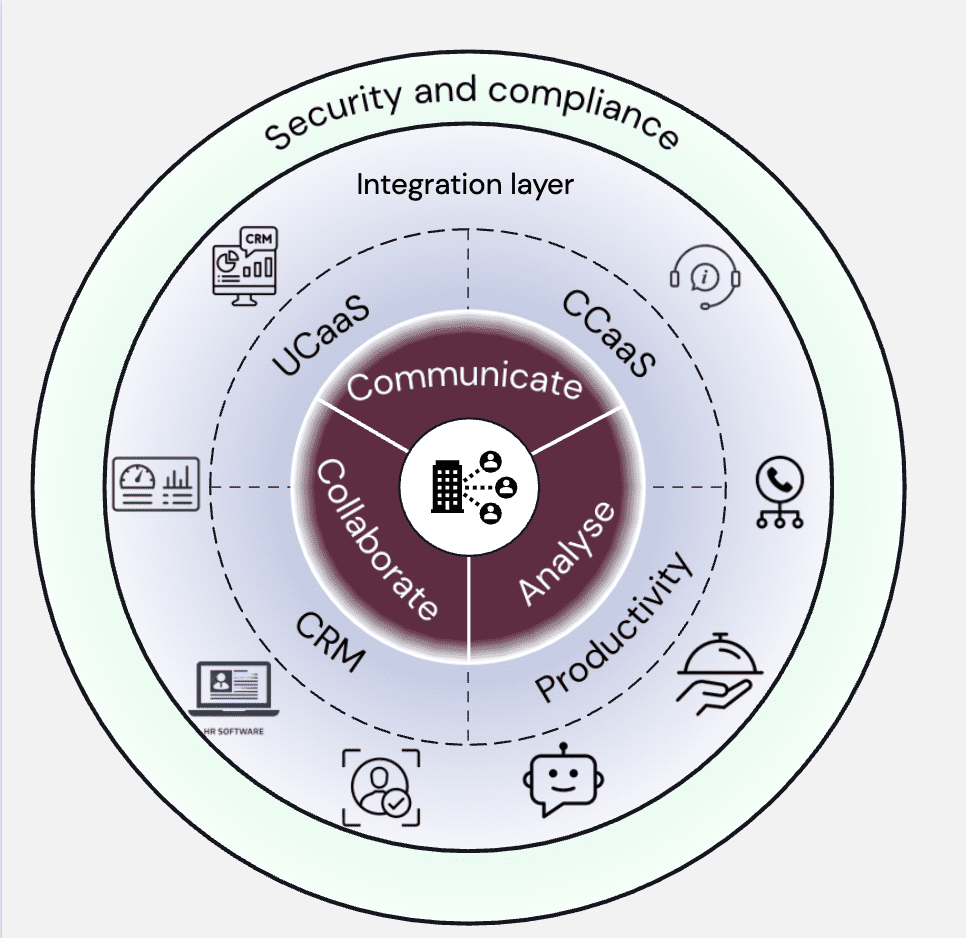Introducing the Intelligent Workplace
The business world is experiencing an unprecedented shift in how people work and communicate, fundamentally changing what employees and customers expect from businesses and technology.
As we scratch the surface of what artificial intelligence can do, traditional siloes are starting to break down – pathing the way for an interconnected fabric of technology where data flows freely and, ultimate, improves communication experiences.
At Cavell, we call this the Intelligent Workplace.
What is the Intelligent Workplace?
The Intelligent Workplace is an integrated approach to business communications that transcends traditional technology boundaries and focuses on delivering meaningful outcomes.

Cavell Managing Director, Matt Townend, introduced the Intelligent Workplace at Cavell’s recent Summit EU, positioning it as the natural evolution of communications technology. Rather than viewing UC, CC collaboration tools as separate silos, this approach integrates these capabilities alongside emerging technologies.
At its core, the Intelligent Workplace represents a shift from technology-centric thinking to outcome-oriented implementation – a theme that resonated throughout Cavell Summit EU. Instead of focusing on specific products or features, it emphasises how technology can address fundamental business challenges.
The Pillars of the Intelligent Workplace
According to presentations at the summit, a comprehensive Intelligent Workplace incorporates several key technological components:
- Unified Communications serves as the backbone, providing a single platform for voice, video, messaging, and presence
- Collaboration Technology has evolved beyond simple file sharing to become comprehensive workspaces
- Contact Centre as a Service solutions revolutionise customer engagement with omnichannel support and AI-powered analysis
- Communications Platform as a Service enables embedding real-time communication directly into applications
- CRM systems provide crucial context for communications across all touchpoints
- Vertical Applications address industry-specific workflows that generic solutions cannot efficiently solve
- Line of Business Applications must integrate seamlessly to create cohesive workflows
- Security, Networking, and Infrastructure underpin everything, ensuring data protection across all systems
Multiple sessions at Cavell Summit Europe noted the increasing convergence of CCaaS and UCaaS technologies, as well as the need for meeting room technology revamps to support hybrid work models – further evidence that traditional product category boundaries are breaking down.
Verticalisation: The Key to Differentiation in a Commoditised Market
Verticalisation is an essential pillar of the Intelligent Workplace.
Developing industry-specific solutions represents a compelling strategy for differentiation and value creation in an increasingly commoditised market.
This approach is already paying dividends for some providers. 8×8, for example, is seeing success with housing authority solutions in the UK, demonstrating how deep industry knowledge translates into effective problem-solving. Rather than offering generic communications tools, these solutions address specific workflows and compliance requirements unique to social housing providers.
Other providers have taken similar steps in other verticals, GoTo, for example, has specialised in car dealerships while Zoom recently announced a communications platform for clinicians.
However, it’s important to have a point and a reason to verticalise – a clear value proposition that resonates with specific industry segments.
For service providers, verticalisation offers a path to combat price pressure of generic communications services. By developing intellectual property and expertise in specific sectors, providers can command premium pricing while building more strategic, longer-term customer relationships.
The practical implementation varies significantly based on provider size and capability. Larger organisations might develop comprehensive solutions for major industry segments like healthcare or financial services. Smaller providers often find success by focusing on niche segments with specific requirements not well-served by mainstream offerings.
Integration: The Essential Glue
Integration is a critical enabler of the Intelligent Workplace vision. Panellists across multiple sessions emphasised the importance of APIs, interoperability, and extensible platforms that can bring together previously disconnected systems.
The true value emerges when unified communications, collaboration tools, CCaaS, and CPaaS work in harmony under robust security protocols. This integration gives customer service agents access to complete customer histories without switching applications, enables teams to seamlessly transition between communication modes, and provides executives with comprehensive cross-channel analytics.
Everything Underpinned by Security
Data sovereignty and security considerations featured prominently in discussions, reflecting growing concerns about regulatory compliance and data governance.
The Intelligent Workplace must balance innovation with robust security controls, particularly as AI and automation gain prominence in business communications. Summit discussions highlighted the importance of implementing comprehensive security strategies that protect all components while enabling seamless communication and collaboration.
The Implementation Challenge
As organisations implement Intelligent Workplace initiatives, they face several significant hurdles that were acknowledged throughout the summit:
- Interoperability remains a primary concern when integrating diverse systems
- User adoption requires comprehensive training programmes and change management
- Security integration demands careful balance to maintain protection while preserving usability
Perhaps most importantly, multiple speakers noted that technology alone cannot drive transformation. Success requires a holistic approach encompassing technology, business processes, organisational change, and partner enablement.
Beyond Technology to Business Outcomes
The concept aligns perfectly with the changing customer expectations articulated throughout the summit. Businesses in 2025 aren’t interested in simply moving voice services to the cloud; they want solutions that solve specific business problems.
This shift away from technical specifications toward business outcomes represents a fundamental evolution in how communications technology is positioned and sold. Service providers must evolve beyond product delivery to become trusted advisors who can guide customers through this complex journey, meeting them where they are today and helping them evolve,
As businesses navigate hybrid work models, rising customer expectations, and economic pressures, the Intelligent Workplace offers a compelling vision for how communications technology can deliver meaningful business value.
For service providers and technology vendors, embracing the Intelligent Workplace provides a path for developing solutions that address genuine customer needs rather than simply pushing the latest technology trends – a vital distinction in an increasingly competitive market.
